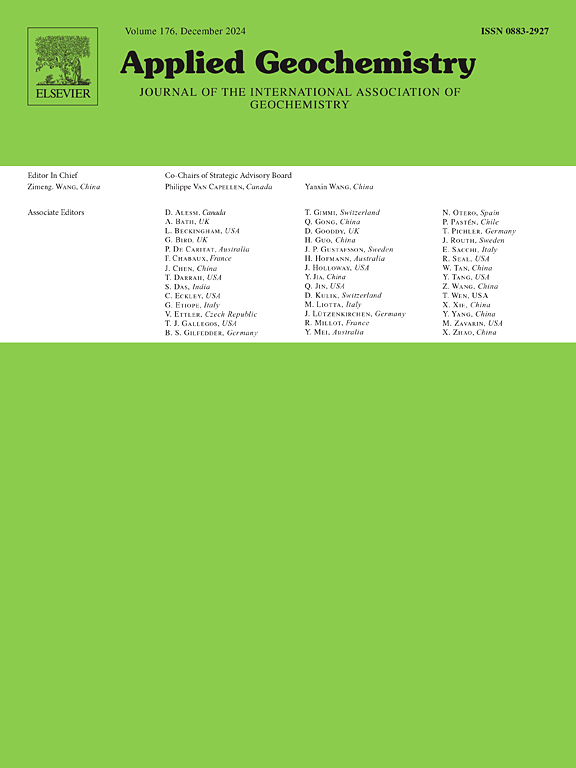中国北方半干旱地区农牧生态区地下水中硝酸盐的来源识别:来自 MixSIAR 模型和 DOM 荧光的耦合证据
IF 3.1
3区 地球科学
Q1 GEOCHEMISTRY & GEOPHYSICS
引用次数: 0
摘要
在中国北方广阔的农牧生态区,地下水是一种宝贵的资源,但却遭受着严重的硝酸盐污染。然而,农牧业活动对该地区地下水硝酸盐累积的影响程度仍不清楚。本研究旨在利用基于双稳定同位素和溶解有机物(DOM)荧光的 MixSIAR 模型,确定中国北方半干旱地区典型的农牧生态区--察哈尔盆地地下水硝酸盐的主要来源。水化学和同位素结果表明,地下水硝酸盐浓度较高(高达 208.19 mg/L),反硝化作用较弱,硝酸盐累积主要由不同来源的混合输入驱动。MixSIAR 模型结果表明,对地下水硝酸盐累积贡献最大的是粪便和amp;污水,其次是土壤氮、化肥和大气沉降。根据 DOM 荧光特征,地下水受畜禽粪便影响较大,其次是土壤腐殖质。此外,根据硝酸盐来源的贡献与荧光成分百分比之间的显著相关性,DOM 荧光结果进一步支持了 MixSIAR 模型的结果,共同证实了地下水中硝酸盐的主要来源是粪便和污水,其次是土壤氮。这些研究结果表明,MixSIAR 模型和 DOM 荧光的耦合证据可用于确定地下水中硝酸盐的来源,这种耦合可为地方当局实现可持续地下水管理提供有价值的信息。本文章由计算机程序翻译,如有差异,请以英文原文为准。

Source identification of nitrate in groundwater of an agro-pastoral ecotone in a semi-arid zone, northern China: Coupled evidences from MixSIAR model and DOM fluorescence
In the extensive agro-pastoral ecotone of northern China, groundwater is a valuable resource, but it suffers from severe nitrate pollution. However, the extent of the contributions of agricultural and pastoral activities to nitrate accumulation in the groundwater of the region remains unclear. This study aimed to identify the main sources of groundwater nitrate in Chahannur Basin, a typical agro-pastoral ecotone in the semi-arid zone of northern China, using the MixSIAR model based on dual stable isotopes and dissolved organic matter (DOM) fluorescence. The hydrochemical and isotopic results showed that the groundwater has high concentrations of nitrate (up to 208.19 mg/L) with weak denitrification, and nitrate accumulation is mainly driven by mixed input from different sources. The MixSIAR model results indicated that the largest contributors to groundwater nitrate accumulation are manure & sewage, followed by soil nitrogen, chemical fertilizers, and atmospheric deposition. According to the DOM fluorescence characteristics, the groundwater is strongly affected by livestock and poultry waste, followed by soil humic substances. Moreover, the DOM fluorescence results further supported the MixSIAR model results based on the significant correlation between the contributions of nitrate sources and the percentages of fluorescent components, jointly confirming that the main source of nitrate in groundwater is manure and sewage, followed by soil nitrogen. These findings indicate that coupled evidences from the MixSIAR model and DOM fluorescence could be applied to identify the sources of nitrate in groundwater, and this coupling can provide valuable information for local authorities to achieve sustainable groundwater management.
求助全文
通过发布文献求助,成功后即可免费获取论文全文。
去求助
来源期刊

Applied Geochemistry
地学-地球化学与地球物理
CiteScore
6.10
自引率
8.80%
发文量
272
审稿时长
65 days
期刊介绍:
Applied Geochemistry is an international journal devoted to publication of original research papers, rapid research communications and selected review papers in geochemistry and urban geochemistry which have some practical application to an aspect of human endeavour, such as the preservation of the environment, health, waste disposal and the search for resources. Papers on applications of inorganic, organic and isotope geochemistry and geochemical processes are therefore welcome provided they meet the main criterion. Spatial and temporal monitoring case studies are only of interest to our international readership if they present new ideas of broad application.
Topics covered include: (1) Environmental geochemistry (including natural and anthropogenic aspects, and protection and remediation strategies); (2) Hydrogeochemistry (surface and groundwater); (3) Medical (urban) geochemistry; (4) The search for energy resources (in particular unconventional oil and gas or emerging metal resources); (5) Energy exploitation (in particular geothermal energy and CCS); (6) Upgrading of energy and mineral resources where there is a direct geochemical application; and (7) Waste disposal, including nuclear waste disposal.
 求助内容:
求助内容: 应助结果提醒方式:
应助结果提醒方式:


